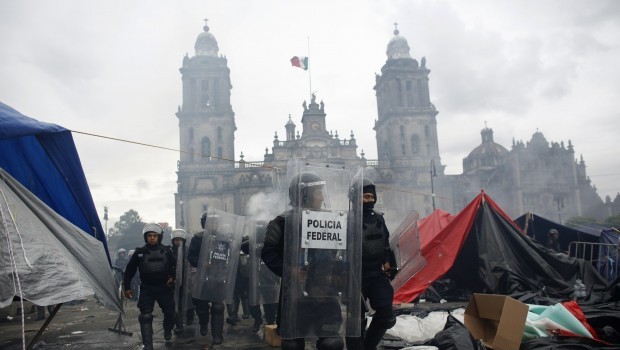
Riot policemen walk in front of the cathedral on the Zócalo after dispersing demonstrators in Mexico City. (REUTERS/Tomas Bravo)
Workers moved swiftly late Friday to demolish the half-burnt protest camp where striking teachers had camped out for weeks in a bid to block Peña Nieto’s education reforms, which are aimed at introducing teacher evaluations and reducing union discretion in hiring.
But while Peña Nieto can now use the vast main square known as the Zócalo to hold the country’s traditional Independence Day celebration on Sunday, it is unknown whether the crackdown will heighten opposition to his energy and tax reforms.
Moving against the striking teachers may have set the tone for any future protests of Peña Nieto’s proposals for a steep tax hike and profits-sharing contracts for private companies in the state-owned oil industry. Both the tax and oil proposals have drawn howls of opposition.
Friday’s massive raid by thousands of police against the teachers was a dramatic reassertion of state authority after weeks of near-constant disruption in the center of one of the world’s largest cities. The teachers have marched through the capital at least 15 times over the last two months.
Authorities did not immediately report any injuries. Federal police chief Manuel Mondragon said 31 demonstrators were arrested, none of them teachers.
There had been mounting pressure to clear out the teachers before the first Independence Day celebration Peña Nieto will lead as president in the massive colonial-era square on Sunday night, followed by a military parade Monday.
The confrontation erupted after the teachers armed themselves with metal pipes and blocked off the Zócalo with steel grates and plastic traffic dividers, threatening to scuttle the Independence Day gathering.
The teachers, many veterans of similar battles with police in poor southern states, vowed to not move from the square where they have camped out since last month. Some fixed knives and nails to wooden planks and declared themselves ready to fight. Others set up sewage-filled portable toilets in the path of police vehicles.
Shortly after 4 p.m., the police swarmed in, firing tear gas canisters and spraying water from armored trucks. Protesters hurled sticks and chunks of pavement broken from the streets around world-famous tourist attractions including the Metropolitan Cathedral, the Templo Mayor and the National Palace.
But within a half hour, police had cleared the Zócalo and much of the surrounding historic center of virtually all demonstrators. Union organizers said they would reassemble away from the main plaza at the nearby Monument to the Revolution. Small knots of teachers, self-described local anarchists and other supporters hurled bottles and rocks at police on some of the main downtown avenues.
“We’re going to reorganize and go back,” said a masked teacher who gave only his first name, Juan Carlos, as he waited in an alley with about 10 other demonstrators. “It’s not going to stay like this. The government isn’t going to repress us.”
Peña Nieto’s new standardized system of test-based hiring and promotion is expected to give the government the tools to break teachers unions’ near-total control of school staffing. That control includes the corrupt sale and inheritance of teaching jobs, and it has been widely blamed for much of the poor performance of Mexican schools, which have higher relative costs and worse results than any other country in the 34-member Organization for Economic Cooperation and Development.
With the education reforms now law, the teachers say they are trying to maintain pressure to protect their rights and privileges as the government puts the changes into effect and reduces union control over teacher hiring and assignment.
The protests were led by the National Education Workers Coordinating Committee, or CNTE, the smaller of the country’s two main teachers unions. The larger union has supported Peña Nieto’s reform.
The teachers argue that because they are from poor states and don’t have the means to enact peaceful change, their main strength is the ability to shut schools and make life inconvenient in Mexico’s economic, political and cultural heart.
